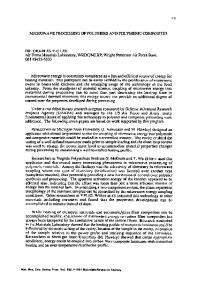Microwave Processing of Silicon Nitride
- PDF / 1,173,503 Bytes
- 6 Pages / 420.48 x 639 pts Page_size
- 51 Downloads / 338 Views
MICROWAVE PROCESSING OF SILICON NITRIDE T. N. Tiegs, J. 0. Kiggans, Jr., and H. D. Kimrey, Jr. Metals and Ceramics Division, Oak Ridge National Laboratory, P.O. Box 2008, Oak Ridge, TN 37831-6069 ABSTRACT Microwave sintering of Si3N4-based materials showed improved densification as compared to samples heated conventionally under similar conditions. Accelerated nitridation of Si in the microwave furnace to produce Si3N4 was also observed. Dense Si3N4, annealed by microwave heating, exhibited enhanced grain growth; however preferential coupling of the microwave power to the grain-boundary phases in the present experiments resulted in their degradation. INTRODUCTION Microwave processing of ceramic materials is an emerging technology that is currently the subject of much research.1 It offers the possibility to produce unique ceramic microstructures and thus, unique properties unobtainable with conventional heating. Currently, sintering of ceramics with microwaves has been demonstrated with A1203, A1203-TiC, A1203-SiC, Y203, and B4C .2-6 Silicon nitride, which represents a large family of materials, is established as the leading candidate for hightemperature engineering applications in advanced heat engines including gas turbines. A study was initiated in 1989 to investigate the processing of silicon nitride ceramics using microwave heating. The objective of this research was to identify those aspects of microwave processing of silicon nitride that might accelerate densification or produce unique microstructures. The sintering of silicon nitride involved two approaches. The first comprised heating of silicon nitride powder compositions in a 2.45- or 28-GHz microwave furnace to determine densification behavior. The second approach dealt with nitridation of silicon to produce reaction-bonded silicon nitride and was done entirely in the 2.45-GHz microwave furnace. The present study examined only the initial nitridation reaction and did not include any subsequent sintering operations. Microstructural development was investigated by annealing of dense silicon nitride materials in a 2.45-GHz microwave furnace. The present study emphasized the use of the 2.45-GHz furnace because of their wide availability and thus their greater nearterm applicability on a commercial scale. EXPERIMENTAL PROCEDURE Si
The silicon nitride samples were produced by milling the a, Y20 3 b, and A120 3 c powders together in isopropanol for 2
3 N4
aUbe Corp., Japan; Grade E-10. bMolycorp, Louviers, CO; Grade 5600, >99.99%. cCeralox Corp., Tucson, AZ; Grade HPA. Mat. Res. Soc. Symp. Proc. Vol. 189. 01991 Materials Research Society
268
to 6 h and drying. Specimens for the sintering experiments were then isopressed into -100 g cylinders at 20 MPa. Specimens for the annealing study were hot-pressed in graphite dies under 0.1 MPa nitrogen to full density. The pressing conditions were 1725 to 1775'C for 1 h and 24 MPa. All of the microwave and conventional sintering and annealing was done with the samples buried in a powder mixture of Si3N4-2 wt % Y203
Data Loading...




